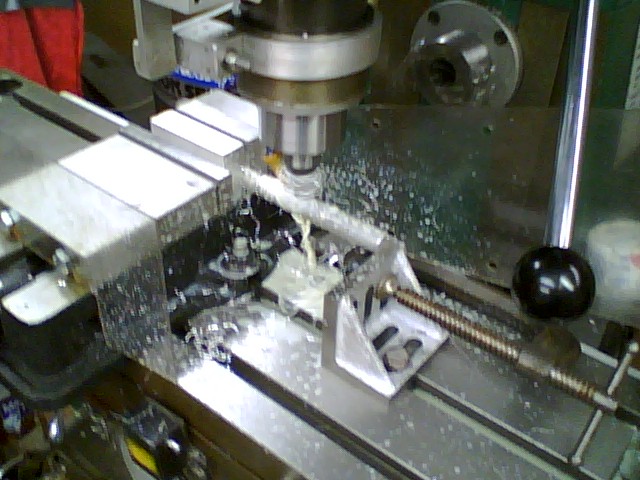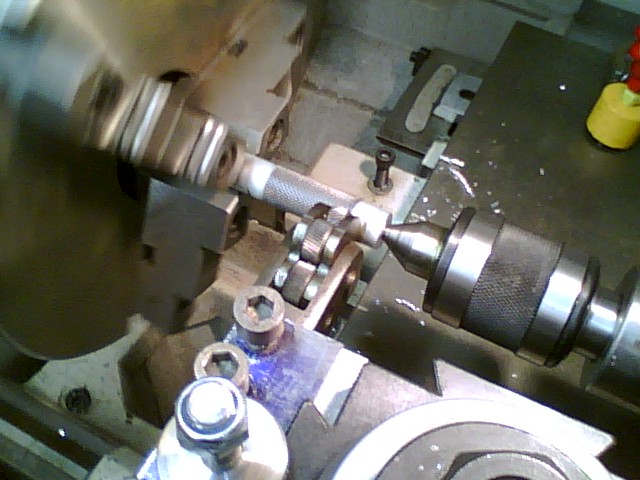Technical Details
In 2009, someone spotted this idea in some photos on an older base-jumping site and discussed it at some length on one of the caving boards, calling the idea "suicide." When I learned of the idea, I made two extended bars to try the idea for myself. Instead of making an entire rack, I used a duplicate SMC angled rack and some REI brake bars (later replaced with SMC bars) that I had laying around to complete the set. I will not describe the rack
frame or other bars here, other than to say that the entire setup is 362 mm. tall, 215 mm. wide, 47 mm. thick, and weighs 836 g.

 I scaled dimensions off the pictures on the web site of interest and then went down to the garage and took some 3/4" 6061-T6 round stock, cut it to length, chucked it in the lathe, and turned the ends smooth. I then made a bar holder, clamped the bars in the milling machine vise, supported the free end, and milled holes and slots in the right places, using an SMC brake bar as a pattern. To make the bars look cool (and to provide a good grip), I chucked them back in the lathe and knurled what would be the outer ends of each bar with a medium diamond knurl. Each resulting extended brake bar is 215 mm. tall, 20 mm. wide, 20 mm. thick, and weighs 166 g.
I scaled dimensions off the pictures on the web site of interest and then went down to the garage and took some 3/4" 6061-T6 round stock, cut it to length, chucked it in the lathe, and turned the ends smooth. I then made a bar holder, clamped the bars in the milling machine vise, supported the free end, and milled holes and slots in the right places, using an SMC brake bar as a pattern. To make the bars look cool (and to provide a good grip), I chucked them back in the lathe and knurled what would be the outer ends of each bar with a medium diamond knurl. Each resulting extended brake bar is 215 mm. tall, 20 mm. wide, 20 mm. thick, and weighs 166 g.
A few people on the web ridiculed this idea without actually making bars and trying the idea. I prefer to try things first, and felt particularly so in this case, because I saw a method to the madness. One of the web pictures showed the rack rigged around face level with the rappeller gripping the two bars in each hand in what I describe as a chin-up technique (or is it prayer technique?). Here are some observations that some people would view as positive features of this technique:
- If the rappeller panics and pulls both bars down, the bottom bar hits the nut and stops. As the rappeller continues to pull the upper long bar down, it squeezes the rope between the two long bars. This tends to slow the rappeller down, and that would be good.
- If the rappeller panics and pushes both bars up, it just jams all the bars together. This would slow the rappeller down, and that would be good.
- If the rappeller panics and just squeezes the extended bars together, they squeeze the rope, and the multiplying effect in the upper bars is to slow the rappeller down: that would be good.
If the rappeller lets go, they are no more or less hosed than with conventional rack technique. Using the right number of bars helps. I normally rappel with five bars, so I chose to use that number for testing.
Of course, one could also use conventional rack technique with the extended bars. The long bars get in the way a bit, but I could live with that; however, the long bars have no advantage in this case. Many of us think that conventional technique works best with the plane of the rack perpendicular to the body. When I tried this with the long bars, they tried to stab me in the gut (or chest. Or throat. Or face). That, I feel, is not good.
My main objection is that this rig is just too big to lug around caving. It solves a problem that doesn't really exist for those of us used to conventional rack technique, and perhaps no one else should be using a rack. I won't be adding extended bars like these to my normal caving racks, but I think that the people who called this technique "suicide" without trying it probably overlooked some of the finer points about how these can actually work.

For far more content, use a larger monitor and a full-width window.
Hundreds of cell phone users complained and asked me to for a simpler, mobile friendly site. In particular, they wanted me to limit each page to a small number of pictures and minimize my use of text. This new site provides what they asked for.



